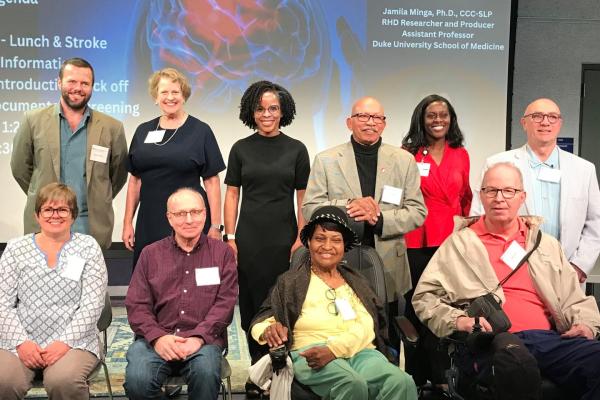
A key mission for Duke Head and Neck Surgery & Communication Sciences(HNS&CS) researcher Jamila Minga, PhD, and her Minga Right Hemisphere Communication Laboratory, is to increase awareness of right hemisphere stroke (RHS). But they can’t spread the word on their own. That’s where the support of people like Linda Fetko, MD, is invaluable.
Dr. Fetko, a Duke alumna and Assistant Professor of Obstetrics and Gynecology at Duke, volunteered to participate in research to develop the RHDBank, an internationally shared database for the study of language use after right hemisphere stroke. After being part of that research, she wanted to further advance research of communication disorders after right hemisphere stroke.
“As a right hemisphere stroke survivor, I have first-hand experience of how frustrating it is to find support for this ‘hidden diagnosis,’” Dr. Fetko said. “I was very fortunate to have found Dr. Minga and her team.
Dr. Fetko provided support to the new Right Hemisphere Stroke Research and Education Fund. The fund will help cover ancillary expenses to enhance general awareness and research progression concerning language use in communication after right hemisphere stroke.
“We aim to educate and enhance awareness of the functional impact of right hemisphere damage (RHD) among the local community, health care professionals, survivors, and their families,” Dr. Minga said. “We hope that in the near future a multidisciplinary clinic dedicated to right hemisphere stroke survivors and their loved ones can offer the needed transitional services to positively impact stroke outcomes.”
Increasing Awareness and Community Support
Thanks in part to the fund, Minga Right Hemisphere Communication Lab members have presented at the American Speech-Language and Hearing Annual Convention (ASHA), the Academy of Neurologic Communication Disorders and Sciences (ANCDS), and the National Black Association of Speech-Language and Hearing (NBASLH) annual conference in 2024.
The lab is also building community for right hemisphere stroke survivors and their loved ones to enhance awareness. As part of these efforts, they’ve done an RHD awareness walk through Duke University Hospital; administered speech-language, cognitive, and hearing screening at the Black Family Wellness Expo; and offered talks on campus and at a number of other universities.
In addition, Dr. Minga and members of her lab, lightheartedly known as “the Minions,” participated in regional screenings of the “RHD: Hidden Diagnosis” documentary, which provides an intimate look at the challenges and triumphs of RHD survivors. The documentary will be nationally distributed by PBS, which will broaden exposure to right hemisphere brain damage after stroke, the disorders that result from RHS, and the impact on survivors and loved ones.
Improving Patient Care Through Understanding
Improved acknowledgment of communication disorders after RHD is imperative to optimizing stroke outcomes and essential to the engineering of diagnostic and treatment approaches. The Right Hemisphere Stroke Research and Education Fund will help Dr. Minga continue and advance her efforts.
“Healthcare practitioners can’t inform right hemisphere stroke survivors of language use changes that can impact their communication if they don’t recognize them,” she said. “Right hemisphere stroke survivors can’t change what they don’t recognize. Loved ones can’t develop an understanding that their loved one’s language has changed during communication if they are never informed that these things can and often do happen.”
Dr. Minga has a paper in preparation in collaboration with a few stroke survivors that describes Right Click, an 11-week group communication treatment program. The aim of Right Click is to enhance the awareness of potential communication challenges after RHD while offering strategies to improve communication breakdowns among right hemisphere stroke survivors and their loved ones.
“It’s hoped that Right Click will contribute to enhanced awareness of communication deviances such that compensatory strategies or different communicative approaches can be applied and self-advocacy for provisional services can occur,” Dr. Minga said. “As a consequence, we hope that relationships can be maintained.”
The Critical Role of Donor Support
“When you think about it, communication is an aspect of everyday living that those who are unaffected by a stroke themselves or by a family member take for granted. Yet, for up to 80% of individuals who survive a right hemisphere stroke the ability to use language appropriately and efficiently is impaired,” Dr. Minga said. “This can cause irreparable harm to relationships particularly when the potential consequences are not communicated well after the stroke.”
The Right Brain Stroke Research and Education Fund will help to broaden the understanding and study of these language impairments after right hemisphere stroke—and improve the lives of those who have experienced communication impairment that impairs the ability to use contextually appropriate language after a right hemisphere stroke.
If you have a passion for improving communication for RHD survivors, please give what you can.